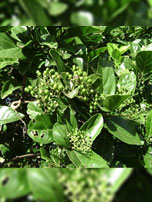SHAHEED KARTAR SINGH SARABHA AYURVEDIC MEDICAL COLLEGE & HOSPITAL
Affiliated to Guru Ravidas Ayurved University, Hoshiarpur Punjab
Affiliated to Guru Ravidas Ayurved University, Hoshiarpur Punjab

Botanical Name : Premna integrifolia Linn
Family : Verbenaceae
Introduction :
Agnimanta is a very important plant during Vedic period wherein its stem/sticks were used to produce fire. It is a plant considered essential for rituals also.
Names in different Indian languages :
English : Headache tree
Hindi : Arni, ageta
Kannada : Takkila
Malayalam : munjna
Sanskrit : Agnimantha (Kerala)
Tamil : Munnai
Telugu : padmaka
Folk : Agethaa, Ganiyaari
Synonyms :
Shriparni, Jayee, Ganikaarikaa, Vaataghni, Arani, Ganakãrikã, Jaya, Tarkãri, i Vaijayantika
Premna obtusifolia R. Br
Premna corymbosa auct. non Rottl. & Willd.
Classification according to Charaka, Susrutha & Vagbhata :
Charaka
Sothahara, sitaprasamana, Anuväsanopaya
Susrutha
Viratarvãdi, Varunadi, Vatasamsamana
Vagbhata
Viratarvãdi, Varunadi,
Varieties & adulterants – (CV – controversy, AD – adulterants) :
1. Clerodendrum phiomidis – CV
2. Premna sp. – AD
Morphology :
A large shrub or small tree large branches spinous usually.
Leaves— simple, opposite, broadly oblong or ovate, entire or dentate.
Flowers— in dense corymbs, greenish white, with unpleasant smell.
Fruit— drupe. black coloured, globose.
Seeds— oblong.
Distribution & Habitat :
All over India
Chemical constituents :
Premnazole, beta-sitosterol, luteolin (leaves): aphelandrine, premnine, betulin, ganiarine, ganikarine, caryophellen, premnenol, premnaspirodiene etc.
Properties :
Rasa Tikta, Katu,Kasaya, Madhura
Guna Rüksa, Laghu
Virya Usna
Vipãka Katu
Karma : Kapha-vata hara, sothahara, Dipana, pachana, kustahara, balya
Anti inflammatory, expectorant, digestive, carminative, useful in skin diseases, febrifuge, Carminative, galactagogue
Indication :
Pãndu, meha, sitapitta, Udara, Kustha, Sthoulya
Rheumatism, fever, diabetes, colic, anorexia, asthma, neuralgia, haemorrhoids
Part used :
Bark, root, leaves
Dosage :
Leaf juice 10-15 ml
Powder 2-4 g
Decoction 50-100 ml
Internal uses :
Nervous System : Used in neuralgia , analgesic
Digestive System : Laxative , digestive
Circulatory System : Useful in bleeding disorder, vasodilator , blood purifier
Respiratory System : Alleviates kapha
Urinary System : It has effects on kapha, meda and urinary tract Therefore useful in urinary disorders. The decoction used in pyuria
Skin : Cures skin disorders. Pulp of its root is given orally in the treatment of urticaria. which has potential to check the pathogenesis of urticaria. The juice of leaves in a dose of 15 ml thrice a day is also useful in urticaria.
Satmikaran : Being a bitter tonic, the juice of leaves and decoction of bark are used in post pyrexial debility and is also useful in anaemia to enhance tissue vitality.
Important Yogas or Formations :
Agnimantha kashaya, Dashamoolaristha
Therapeutic Uses :
(1) meha— Agnimantha or simsipa decoction is useful (S.S.Ci. 11).
(2) Sthoulya— Silajatu is to be given with Agnimantha svarasa (C.S.Su. 21).
